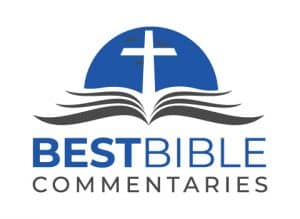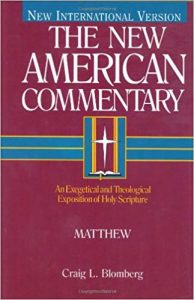Craig Blomberg is the author of the Matthew volume in The New American Commentary series, which focuses on the exegetical and theological exposition of the Gospel. Dr. Blomberg (Aberdeen University, Ph.D) has taught at Denver Seminary since 1986 and currently serves as distinguished professor of New Testament.
Dr. Blomberg completed his PhD in New Testament, specializing in the parables and the writings of Luke-Acts, at Aberdeen University in Scotland. He received an MA from Trinity Evangelical Divinity School, and a BA from Augustana College.
In addition to writing numerous articles in professional journals, multi-author works, and dictionaries or encyclopedias, he has authored or edited 20 books, including [links go to Amazon]:
The Historical Reliability of the Gospels, Interpreting the Parables; commentaries on Matthew (NAC), 1 Corinthians (NIVAC) and James (ZECNT); Jesus and the Gospels: An Introduction and Survey; From Pentecost to Patmos: An Introduction to Acts through Revelation; Christians in an Age of Wealth: A Biblical Theology of Stewardship, Preaching the Parables, Contagious Holiness: Jesus’ Meals with Sinners, and Handbook of New Testament Exegesis.
See how Blomberg’s volume compares to others on the page Best Matthew Commentaries.
Matthew in the NAC Series Q&A
Dr. Blomberg recently agreed to answer my questions about his Matthew commentary in the NAC series, in which he helps readers understand the purpose of the commentary, why it’s unique among Matthew commentaries, and how he was moved in writing it.
1. What previous research and/or personal interests led you to this project and helped prepare you to write this commentary on Matthew?
I had written on both the historical reliability of the Gospels and on the parables of Jesus. While neither topic was limited to Matthew, both involved a fair amount of work with Matthew’s Gospel
2. Who is the intended audience for this commentary? Would it benefit pastors? professors? students? lay Christians in the local church?
At the time the conservative resurgence in the leadership of the Southern Baptist Convention was still comparatively young and Broadman Press (as the predecessor to B & H Academic was called back then), the publishing arm of the SBC, did not have a thoroughly evangelical commentary series on the Bible. The NAC had local pastors particularly in mind but certainly all of the categories you mention were in view to one degree or another.
3. What is unique about this commentary? What contribution does it make to studies of Matthew?
The uniqueness was that it was an entirely evangelical series written by mostly Baptists for a Southern Baptist readership to begin with, though obviously everyone else was welcome to benefit from the series.
It was designed to be a mid-range work that was not too detailed or overly technical but still fully abreast of scholarship, well-footnoted, but written not so much for the scholarly guild as for the church.
It was not that there weren’t such series available or that there weren’t individual commentaries on Matthew of a similar scope, but that the SBC at that time had a very large percentage of people who always looked to Broadman Press first before looking anywhere else (and in some cases, not looking anywhere else at all) that convinced me the series would meet an important need in the Christian community.
See how the New American Commentary series compares to others on the page Best Commentary Series: The Top 50.
4. What section or passage of this commentary was particularly memorable to research and write? Why?
Maybe chapters 8-9. One of the things that I did try to work hard at was a very careful inductive analysis of the overall structure of Matthew. I wound up combining two popular approaches that were usually viewed as mutually exclusive.
But to determine, as best as one can, Matthew’s own mind when he composed the outline of his Gospel, one has to look not only for signs that one has reached a literary seam or dividing point but also consider how each main section is structured internally, to see if a coherent segment of text with a natural beginning, middle and end emerges.
The amount of symmetry I discovered as I examined these three chapters–three healing stories, two teachings on discipleship, three more dramatic miracles (including miracles over nature), two teaching on discipleship, and three healing stories—was fascinating but also significant because it showed Jesus’ authority over disease, disaster and even the demonic world.
5. What personally edified you in writing this commentary, increasing your affections for Christ?
Authors were encouraged to end sections of commentary with brief applicational insights, and preachers or writers ought not try to apply the biblical texts to others until they have applied them to themselves first.
I suppose the Sermon on the Mount is perennially the most challenging, convicting, and edifying part of this Gospel for many people, and wrestling with the many different approaches to the Sermon down through history enabled me both to solidify my views of Jesus and social ethics and confirm several of our family’s ministry commitments as a result.
Also see Best One-Volume Whole Bible Commentaries for more options.
6. Besides your commentary, what are your top recommended books (commentaries or otherwise) on Matthew? [links go to Amazon]
It’s been 25 years since my commentary was published so a lot of good works have come out since. Grant Osborne (ZECNT), John Nolland (NIGTC) and Don Hagner (WBC) have written very detailed and helpful works. R. T. France (NICNT), Craig Evans (NCBC), D. A. Carson (EBC rev.) and Craig Keener (Socio-Rhetorical) have written good mid-range works, though all of them are at least somewhat more detailed than mine.
Focusing on exposition and/or contemporary application but also thoroughly abreast of the original meaning of the text are Keener (NTC), Michael Wilkins (NIVAC), Jeannine Brown (Teach the Text) and Ben Witherington (Smyth & Helwys).
7. What is next for you? What project are you currently working on? How can people follow your work and ministry?
Next for me today is not the same as next after Matthew, because I have been privileged to publish about twenty more books since. I am currently working on a New Testament theology for Baylor University Press.
Amazon has a full complement of my books for those who are interested in seeing what I have done. Ministry and travel are posted on the Denver Seminary website (www.denverseminary.edu) under Faculty.
Own Craig Blomberg’s Matthew commentary
The link provided will direct you to this volume via it’s exact ISBN number:
- Get Dr. Blomberg’s commentary on Matthew at Amazon
- Get Dr. Blomberg’s commentary on Matthew on Christian Book Distributors
Also see Best Bible Commentaries Q&A with Richard Bauckham on Jesus and the Eye Witnesses
Also see Best Revelation Commentaries for more options.
Recent Posts
David Jeremiah, a renowned pastor, author, and speaker, has captivated the hearts of many with his compelling sermons. His messages resonate deeply with diverse audiences, leaving an enduring...
Tim Keller, a distinguished pastor, theologian, and author, has garnered a devoted following through the profound impact of his sermons. In this article, we will explore seven compelling reasons...

